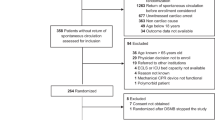Summary
The aim of the present study was to determine the acute and long-term outcome of in-hospital and out-of-hospital cardiopulmonary resuscitation (CPR) in a single community hospital.
In a prospective observational study all consecutive patients (pts) who underwent CPR during a two year period (1/1994 – 12/1995) were registered. The data were evaluated with special regard to short- and long-term survival, variables which predicted survival, and functional status of surviving pts.
201 pts suffered a total of 211 cardiopulmonary arrests. Seventy four pts were female and 127 pts were male. Ten pts suffered 2 cardiopulmonary arrests and data were calculated on the result of the second arrest. Of all pts, 114 (56.7%) could be stabilized after CPR and survived initially. 105 pts (52.2%) were alive 24 hours after CPR, and 47 (23.4%) survived to discharge. The functional status at discharge was determined using the modified Rankin scale (RS): RS 0: 21 pts (44.7%); RS 1: 9 pts (19.2%); RS 2: 5 pts (10.6%); RS 3: 5 pts (10.6%); RS 4: 6 pts (12.8%); and RS 5: 1 pt (2.1%). Of the 47 pts discharged alive, 36 (17.9%) were alive at a mean follow-up of 85.8±30.8 weeks after CPR. The survival rates of out-of-hospital (20 of 67 pts; 29.9%) and in-hospital CPR (27 of 134 pts; 20.1%) were not significantly different (p = 0.1256). The highest mortality carried CPR in the intensive care unit with only 13 of 83 pts (15.7%) surviving to discharge. This result was statistically significantly different compared with all other cases of CPR (out-of-hospital, emergency room, and ward) where 34 of 118 pts (28.8%) survived to discharge (p = 0.0301). Multivariate analysis identified age, cardiac rhythm, and initial pH as predictors of outcome in in-hospital CPR. In out-of-hospital CPR cardiac rhythm and delay to CPR were predictive of survival (all p<0.05).
The results of CPR are poor and seem not to have improved with other improvements of medical care when compared with data from the literature. One of many reasons is probably the missing selection of pts even in in-hospital CPR and the infrequent use of Do-Not-Resuscitate (DNR) orders.
Zusammenfassung
Das Ziel der Studie war, die Akut- und Langzeitergebnisse nach cardiopulmonaler Reanimation (CPR) innerhalb und außerhalb eines einzelnen Krankenhauses der Schwerpunktversorgung zu ermitteln.
In einer prospektiven Beobachtungsstudie wurden konsekutiv alle cardiopulmonal reanimierten Patienten innerhalb von zwei Jahren (1/1994 – 12/1995) erfaßt. Die Daten wurden analysiert unter besonderer Berücksichtigung folgender Punkte: Kurz- und Langzeitüberlebensraten, klinische Faktoren, die das Outcome der Patienten bestimmen und der funktionelle Status der Patienten nach CPR.
201 Patienten erlitten insgesamt 211mal einen Herz-Kreislaufstillstand. 74 (36,8%) Patienten waren weiblich und 127 waren männlich (63,2%). 10 Patienten wurden im Beobachtungszeitraum jeweils zweimal reanimationspflichtig und die Datenanalyse beruht auf dem Ergebnis der zweiten Reanimation. Insgesamt 114 Patienten (56,7%) konnten initial stabilisiert werden. 105 Patienten (52,2%) lebten 24 Stunden nach CPR, und 47 Patienten (23,4%) wurden lebend aus dem Kranken-haus entlassen. Der funktionelle Zustand dieser Patienten ergab sich nach der modifizierten Rankin-Scale (RS): 21 Patienten in RS 0 (44,7%), 9 Patienten in RS 1 (19,2%), 5 Patienten in RS 2 (10,6%), 5 Patienten in RS 3 (10,6%), 6 Patienten in RS 4 (12,8%) und 1 Patient in RS 5 (2,1%).
36 der 47 entlassenen Patienten (17,9% der Gesamtpatientenzahl) waren nach einem follow-up von 85,8±30,8 Wochen nach CPR noch am Leben. Die Überlebensraten bis zur Entlassung waren nicht signifikant verschieden zwischen Patienten nach CPR außerhalb des Krankenhauses (20 von 67 Patienten (29,9%)) und Patienten nach CPR im Krankenhaus (27 von 134 Patienten (20,1%), p = 0,1256). Die höchste Mortalität hatten Patienten nach CPR auf der Intensivstation (13 von 83 Patienten überlebten bis zur Entlassung (15,7%)). Dieses Resultat war signifikant schlechter als die Ergebnisse aller anderen Reanimationen (außerhalb des Krankenhauses, in der Notaufnahme, auf der Normalstation) mit insgesamt 34 Überlebenden von 118 Patienten (28,8%; p = 0,0301). In der Multi-varianzanalyse fand sich bei der CPR im Krankenhaus das Alter des Patienten, der primäre Herzrhythmus und der initial bestimmte pH-Wert als prädiktive Kriterien für das Resultat der CPR. Bei der CPR außerhalb des Krankenhauses waren die Hypoxiezeit und der primäre Herzrhythmus prädiktive Kriterien für das Überleben (alle p<0,05).
Die Ergebnisse der CPR sind insgesamt schlecht und scheinen sich trotz vielfältiger Verbesserungen in der medizinischen Notfallversorgung – im Vergleich mit Literaturergebnissen der letzten Jahrzehnte – nicht wesentlich geändert zu haben. Ein möglicher Grund ist die fehlende Selektion der Patienten insbesondere im Falle der CPR innerhalb des Krankenhauses. Möglicherweise wird die frühzeitige Entscheidung, einen Patienten prinzipiell nicht zu reanimieren, zu selten getroffen.
Similar content being viewed by others
Author information
Authors and Affiliations
Additional information
Eingegangen: 3. Mai 1997 Akzeptiert: 12. Juni 1997
Rights and permissions
About this article
Cite this article
Carlsson, J., Götz, J., Miketic, S. et al. Kurz- und Langzeitüberleben nach cardiopulmonaler Reanimation. Intensivmed 35, 34–41 (1998). https://doi.org/10.1007/s003900050116
Issue Date:
DOI: https://doi.org/10.1007/s003900050116




